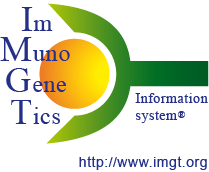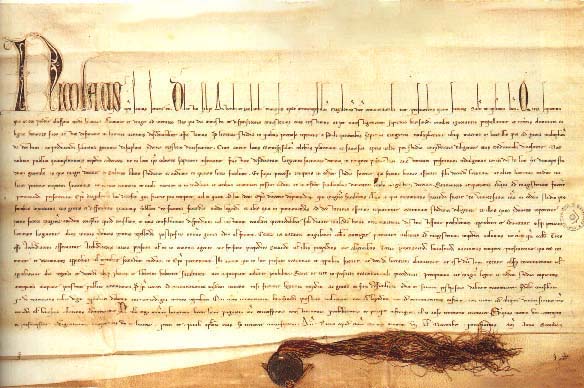|
IMGT
IMGT or the international ImMunoGeneTics information system is a collection of databases and resources for immunoinformatics, particularly the V, D, J, and C gene sequences, as well as a providing other tools and data related to the adaptive immune system. IMGT/LIGM-DB, the first and still largest database hosted as part of IMGT contains reference nucleotide sequences for 360 species' T-cell receptor and immunoglobulin molecules, as of 2023. These genes encode the proteins which are the foundation of adaptive immunity, which allows highly specific recognition and memory of pathogens. History IMGT was founded in June, 1989, by Marie-Paule Lefranc, an immunologist working at University of Montpellier. The project was presented to the 10th Human Genome Mapping Workshop, and resulted in the recognition of V, D, J, and C regions as genes. The first resource created was IMGT/LIGM-DB, a reference for nucleotide sequences of T-cell receptor and immunoglobulin of humans, and later ver ... [...More Info...] [...Related Items...] OR: [Wikipedia] [Google] [Baidu] |
Immunoinformatics
In academia, computational immunology is a field of science that encompasses high-throughput genomic and bioinformatics approaches to immunology. The field's main aim is to convert immunological data into computational problems, solve these problems using mathematical and computational approaches and then convert these results into immunologically meaningful interpretations. Introduction The immune system is a complex system of the human body and understanding it is one of the most challenging topics in biology. Immunology research is important for understanding the mechanisms underlying the defense of human body and to develop drugs for immunological diseases and maintain health. Recent findings in genomic and proteomic technologies have transformed the immunology research drastically. Sequencing of the human and other model organism genomes has produced increasingly large volumes of data relevant to immunology research and at the same time huge amounts of functional and clini ... [...More Info...] [...Related Items...] OR: [Wikipedia] [Google] [Baidu] |
HLA Informatics Group
The HLA Informatics Group (HIG) is a research group led by Professor Steven Marsh at the Anthony Nolan Research Institute that develops, runs and maintains the IMGT (immunogenetics)/HLA ( Human leukocyte antigen) Database and the IPD (immuno polymorphism database). The IMGT/HLA database originated as part of IMGT and was merged with IPD in 2003. The IMGT/HLA Database is a central repository for sequences of the human major histocompatibility complex The major histocompatibility complex (MHC) is a large locus on vertebrate DNA containing a set of closely linked polymorphic genes that code for cell surface proteins essential for the adaptive immune system. These cell surface proteins are calle ... and currently contains over 5,000 allele sequences, including over 1,800 HLA-B sequences. As well as sequence information, the IMGT/HLA Database and the IPD Databases include extensive information regarding the source material that sequences are derived from. The IMGT/HLA website i ... [...More Info...] [...Related Items...] OR: [Wikipedia] [Google] [Baidu] |
Immunomics
Immunomics is the study of immune system regulation and response to pathogens using genome-wide approaches. With the rise of genomic and proteomic technologies, scientists have been able to visualize biological networks and infer interrelationships between genes and/or proteins; recently, these technologies have been used to help better understand how the immune system functions and how it is regulated. Two thirds of the genome is active in one or more immune cell types and less than 1% of genes are uniquely expressed in a given type of cell. Therefore, it is critical that the expression patterns of these immune cell types be deciphered in the context of a network, and not as an individual, so that their roles be correctly characterized and related to one another. Defects of the immune system such as autoimmune diseases, immunodeficiency, and malignancies can benefit from genomic insights on pathological processes. For example, analyzing the systematic variation of gene expres ... [...More Info...] [...Related Items...] OR: [Wikipedia] [Google] [Baidu] |
International Union Of Immunological Societies
The International Union of Immunological Societies (IUIS), a member of the International Council for Science, is an organization which serves as an umbrella organization for many national and regionally grouped immunological societies. The organization was founded in 1969. The ten founding member societies were the American Association of Immunologists, British Society for Immunology, Canadian Society for Immunology, Dutch Society for Immunology, Gesellschaft fur Immunologie, Israel Immunological Society, Polish Society of Immunology, Scandinavian Society for Immunology, Societe Francaise d’immunologie, and Yugoslav Immunological Society. IUIS had 83 member societies in 2019. The 2019-2022 executive committee of the IUIS is Faith Osier, President; Miriam Merad, Vice-President; Roslyn Kemp, Secretary General; Michael Ratcliffe, Treasurer; Alberto Mantovani, Past President. Every three years the IUIS organizes an international congress, called the International Congress of Immu ... [...More Info...] [...Related Items...] OR: [Wikipedia] [Google] [Baidu] |
Genetics Databases
Genetics is the study of genes, genetic variation, and heredity in organisms.Hartl D, Jones E (2005) It is an important branch in biology because heredity is vital to organisms' evolution. Gregor Mendel, a Moravian Augustinian friar working in the 19th century in Brno, was the first to study genetics scientifically. Mendel studied "trait inheritance", patterns in the way traits are handed down from parents to offspring over time. He observed that organisms (pea plants) inherit traits by way of discrete "units of inheritance". This term, still used today, is a somewhat ambiguous definition of what is referred to as a gene. Trait inheritance and molecular inheritance mechanisms of genes are still primary principles of genetics in the 21st century, but modern genetics has expanded to study the function and behavior of genes. Gene structure and function, variation, and distribution are studied within the context of the cell, the organism (e.g. dominance), and within the contex ... [...More Info...] [...Related Items...] OR: [Wikipedia] [Google] [Baidu] |
Open Science Data
Open scientific data or open research data is a type of open data focused on publishing observations and results of scientific activities available for anyone to analyze and reuse. A major purpose of the drive for open data is to allow the verification of scientific claims, by allowing others to look at the reproducibility of results,Spiegelhalter, DOpen data and trust in the literature.The Scholarly Kitchen. Retrieved 7 September 2018. and to allow data from many sources to be integrated to give new knowledge. The modern concept of scientific data emerged in the second half of the 20th century, with the development of large knowledge infrastructure to compute scientific information and observation. The sharing and distribution of data has been early identified as an important stake but was impeded by the technical limitations of the infrastructure and the lack of common standards for data communication. The World Wide Web was immediately conceived as a universal protocol for the sha ... [...More Info...] [...Related Items...] OR: [Wikipedia] [Google] [Baidu] |
Monoclonal Antibodies
A monoclonal antibody (mAb, more rarely called moAb) is an antibody produced from a cell Lineage made by cloning a unique white blood cell. All subsequent antibodies derived this way trace back to a unique parent cell. Monoclonal antibodies can have monovalent affinity, binding only to the same epitope (the part of an antigen that is recognized by the antibody). In contrast, polyclonal antibodies bind to multiple epitopes and are usually made by several different antibody-secreting plasma cell lineages. Bispecific monoclonal antibodies can also be engineered, by increasing the therapeutic targets of one monoclonal antibody to two epitopes. It is possible to produce monoclonal antibodies that specifically bind to virtually any suitable substance; they can then serve to detect or purify it. This capability has become an investigative tool in biochemistry, molecular biology, and medicine. Monoclonal antibodies are being used on a clinical level for both the diagnosis and therap ... [...More Info...] [...Related Items...] OR: [Wikipedia] [Google] [Baidu] |
French National Centre For Scientific Research
The French National Centre for Scientific Research (french: link=no, Centre national de la recherche scientifique, CNRS) is the French state research organisation and is the largest fundamental science agency in Europe. In 2016, it employed 31,637 staff, including 11,137 tenured researchers, 13,415 engineers and technical staff, and 7,085 contractual workers. It is headquartered in Paris and has administrative offices in Brussels, Beijing, Tokyo, Singapore, Washington, D.C., Bonn, Moscow, Tunis, Johannesburg, Santiago de Chile, Israel, and New Delhi. From 2009 to 2016, the CNRS was ranked No. 1 worldwide by the SCImago Institutions Rankings (SIR), an international ranking of research-focused institutions, including universities, national research centers, and companies such as Facebook or Google. The CNRS ranked No. 2 between 2017 and 2021, then No. 3 in 2022 in the same SIR, after the Chinese Academy of Sciences and before universities such as Harvard University, MIT, or Stanf ... [...More Info...] [...Related Items...] OR: [Wikipedia] [Google] [Baidu] |
V(D)J Recombination
V(D)J recombination is the mechanism of somatic recombination that occurs only in developing lymphocytes during the early stages of T and B cell maturation. It results in the highly diverse repertoire of antibodies/immunoglobulins and T cell receptors (TCRs) found in B cells and T cells, respectively. The process is a defining feature of the adaptive immune system. V(D)J recombination in mammals occurs in the primary lymphoid organs ( bone marrow for B cells and thymus for T cells) and in a nearly random fashion rearranges variable (V), joining (J), and in some cases, diversity (D) gene segments. The process ultimately results in novel amino acid sequences in the antigen-binding regions of immunoglobulins and TCRs that allow for the recognition of antigens from nearly all pathogens including bacteria, viruses, parasites, and worms as well as "altered self cells" as seen in cancer. The recognition can also be allergic in nature (''e.g.'' to pollen or other allergens) or m ... [...More Info...] [...Related Items...] OR: [Wikipedia] [Google] [Baidu] |
University Of Montpellier
The University of Montpellier (french: Université de Montpellier) is a public research university located in Montpellier, in south-east of France. Established in 1220, the University of Montpellier is one of the oldest universities in the world. The university was split into three universities (the University of Montpellier 1, the University of Montpellier 2 and the Paul Valéry University Montpellier 3) for 45 years from 1970 until 2015 when it was subsequently reunified by the merger of the two former, with the latter, now named Paul Valéry University, Montpellier III remaining a separate entity. History The university is considerably older than its formal founding date, associated with a papal bull issued by Pope Nicholas IV in 1289, combining all the centuries-old schools into a university, but the first statutes were given by Conrad of Urach in 1220. It is not known exactly when the schools of liberal arts were founded that developed into the Montpellier faculty o ... [...More Info...] [...Related Items...] OR: [Wikipedia] [Google] [Baidu] |


.jpg)

